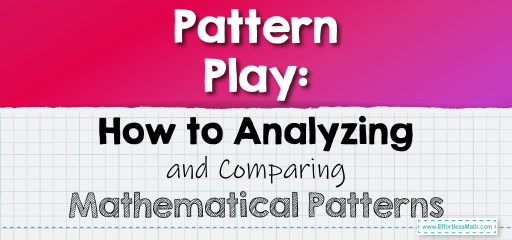Pattern Play: How to Analyzing and Comparing Mathematical Patterns
Patterns are everywhere in mathematics, from simple number sequences to intricate geometric designs.
[include_netrun_products_block from-products="product/6-south-carolina-sc-ready-grade-3-math-practice-tests/" product-list-class="bundle-products float-left" product-item-class="float-left" product-item-image-container-class="p-0 float-left" product-item-image-container-size="col-2" product-item-image-container-custom-style="" product-item-container-size="" product-item-add-to-cart-class="btn-accent btn-purchase-ajax" product-item-button-custom-url="{url}/?ajax-add-to-cart={id}" product-item-button-custom-url-if-not-salable="{productUrl} product-item-container-class="" product-item-element-order="image,title,purchase,price" product-item-title-size="" product-item-title-wrapper-size="col-10" product-item-title-tag="h3" product-item-title-class="mt-0" product-item-title-wrapper-class="float-left pr-0" product-item-price-size="" product-item-purchase-size="" product-item-purchase-wrapper-size="" product-item-price-wrapper-class="pr-0 float-left" product-item-price-wrapper-size="col-10" product-item-read-more-text="" product-item-add-to-cart-text="" product-item-add-to-cart-custom-attribute="title='Purchase this book with single click'" product-item-thumbnail-size="290-380" show-details="false" show-excerpt="false" paginate="false" lazy-load="true"]

Recognizing, understanding, and comparing these patterns is a fundamental skill that aids in problem-solving and prediction. In this guide, we’ll delve into the art of identifying and comparing various mathematical patterns.
Step-by-step Guide to Analyzing and Comparing Mathematical Patterns:
1. Identifying Patterns:
Start by observing the given sequence or set of numbers/figures. Look for regularities or trends. This could be a consistent difference between numbers, a multiplication factor, or a repeating sequence.
2. Describing the Pattern:
Once identified, describe the pattern using words or mathematical notation. For instance, an arithmetic sequence might be described as “each number is 3 greater than the previous number.”
3. Predicting the Next Element:
Using the identified pattern, try to predict the next element(s) in the sequence.
4. Comparing Patterns:
When given multiple patterns:
– Describe each pattern separately.
– Look for similarities and differences in their structure, progression, or other characteristics.
– Determine if one pattern can be transformed into another through some mathematical operation.
5. Using Visual Aids:
For complex patterns, especially those in geometry, use visual aids like graphs, drawings, or charts to better understand and compare them.
Example 1:
Compare the patterns:
Sequence A: 2, 5, 8, 11, …
Sequence B: 3, 6, 9, 12, …
Solution:
Sequence A increases by 3 each time.
Sequence B also increases by 3 each time.
Both are arithmetic sequences with a common difference of 3, but they start with different initial numbers.
The Absolute Best Book for 5th Grade Students
Example 2:
Compare the patterns:
Sequence X: 1, 4, 9, 16, …
Sequence Y: 2, 6, 12, 20, …
Solution:
Sequence X represents the squares of natural numbers.
Sequence Y increases by consecutive even numbers: +2, +4, +6, …
While both sequences increase, they follow different patterns.
Practice Questions:
1. Compare the patterns:
Sequence P: 5, 10, 15, 20, …
Sequence Q: 5, 7, 9, 11, …
2. Compare the patterns:
Sequence M: 3, 6, 12, 24, …
Sequence N: 3, 5, 7, 9, …
A Perfect Book for Grade 5 Math Word Problems!
Answers:
1. Sequence P increases by 5 each time (arithmetic sequence with a common difference of 5).
Sequence Q increases by 2 each time (arithmetic sequence with a common difference of 2).
2. Sequence M doubles each time (geometric sequence with a common ratio of 2). Sequence N increases by 2 each time (arithmetic sequence with a common difference of 2).
The Best Math Books for Elementary Students
Related to This Article
More math articles
- How to Demystify Differences: A Guide to Subtracting Fractions with Unlike Denominators
- 10 Most Common 5th Grade ACT Aspire Math Questions
- Number Properties Puzzle – Challenge 15
- AFOQT Math Practice Test Questions
- Continuity at a point Explained: How to Identify Discontinuities and Their Significance
- Algebra Puzzle – Challenge 50
- How Does the Process of Renting Books from Online Bookstores Work? A Guide for Students
- 10 Most Common 6th Grade MCAS Math Questions
- The Ultimate CLEP College Math Formula Cheat Sheet
- Unlocking the Mystery: How to Add Fractions with Different Denominators Using Visual Models


























What people say about "Pattern Play: How to Analyzing and Comparing Mathematical Patterns - Effortless Math: We Help Students Learn to LOVE Mathematics"?
No one replied yet.